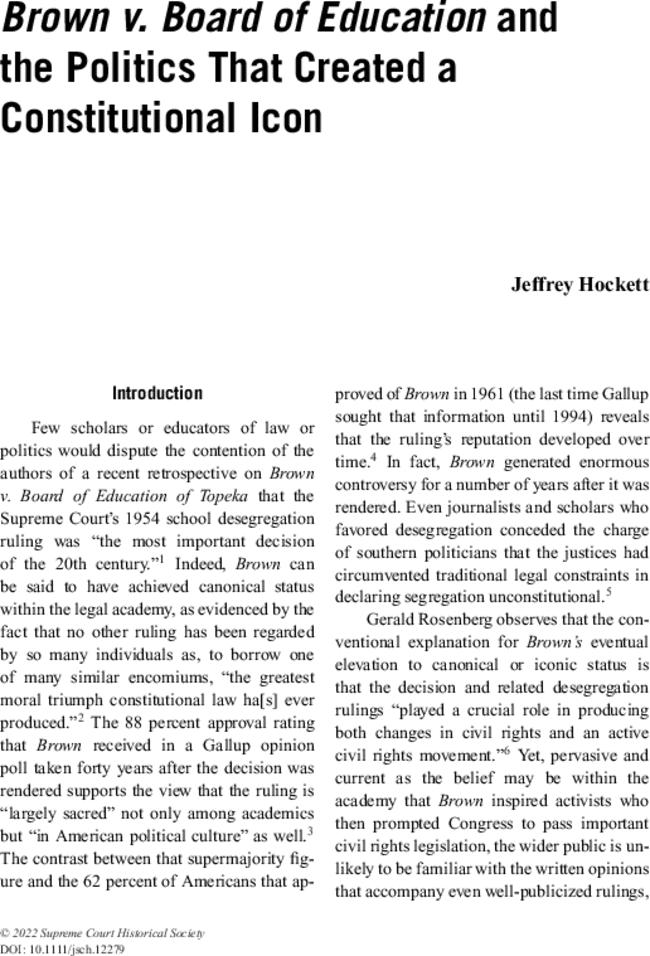Brown v. Board of Education and the Politics That Created a Constitutional Icon
IF 0.2
Q3 HISTORY
引用次数: 0
Abstract
Few scholars or educators of law or politics would dispute the contention of the authors of a recent retrospective on Brown v. Board of Education of Topeka that the Supreme Court’s 1954 school desegregation ruling was “the most important decision of the 20th century.”1 Indeed, Brown can be said to have achieved canonical status within the legal academy, as evidenced by the fact that no other ruling has been regarded by so many individuals as, to borrow one of many similar encomiums, “the greatest moral triumph constitutional law ha[s] ever produced.”2 The 88 percent approval rating that Brown received in a Gallup opinion poll taken forty years after the decision was rendered supports the view that the ruling is “largely sacred” not only among academics but “in American political culture” as well.3 The contrast between that supermajority figure and the 62 percent of Americans that approved of Brown in 1961 (the last time Gallup sought that information until 1994) reveals that the ruling’s reputation developed over time.4 In fact, Brown generated enormous controversy for a number of years after it was rendered. Even journalists and scholars who favored desegregation conceded the charge of southern politicians that the justices had circumvented traditional legal constraints in declaring segregation unconstitutional.5 Gerald Rosenberg observes that the conventional explanation for Brown’s eventual elevation to canonical or iconic status is that the decision and related desegregation rulings “played a crucial role in producing both changes in civil rights and an active civil rights movement.”6 Yet, pervasive and current as the belief may be within the academy that Brown inspired activists who then prompted Congress to pass important civil rights legislation, the wider public is unlikely to be familiar with the written opinions that accompany even well-publicized rulings,

布朗诉教育委员会案和创造宪法象征的政治
很少有学者或法律或政治教育工作者会对最近一篇关于布朗诉托皮卡教育委员会的回顾文章的作者的论点提出异议,即最高法院1954年的学校废除种族隔离裁决是“20世纪最重要的裁决”,事实证明,没有其他裁决被如此多的人视为“有史以来最伟大的道德胜利宪法”,借用许多类似的赞美之一。“2在做出这一决定40年后,盖洛普民意调查显示,布朗获得了88%的支持率,这支持了这样一种观点,即这一裁决不仅在学术界“基本上是神圣的”,而且在“美国政治文化”中也是如此。3这一绝对多数数字与1961年支持布朗的62%美国人之间的对比(直到1994年,盖洛普最后一次寻求这些信息)表明,该裁决的声誉随着时间的推移而发展。4事实上,布朗在裁决后的几年里引发了巨大的争议。即使是支持废除种族隔离的记者和学者也承认了南方政客的指控,即大法官在宣布种族隔离违宪时规避了传统的法律约束。5 Gerald Rosenberg认为,对布朗最终提升为规范或标志性地位的传统解释是,这一决定和相关的废除种族隔离裁决“在促成民权变革和积极的民权运动方面发挥了至关重要的作用。”6然而,尽管学术界普遍认为布朗激励了活动家,促使国会通过了重要的民权立法,但广大公众不太可能熟悉伴随着广为宣传的裁决而来的书面意见,
本文章由计算机程序翻译,如有差异,请以英文原文为准。
求助全文
约1分钟内获得全文
求助全文

 求助内容:
求助内容: 应助结果提醒方式:
应助结果提醒方式:


